新编实用英语综合教程1第四版Unit5ppt课件
- 格式:ppt
- 大小:4.92 MB
- 文档页数:95
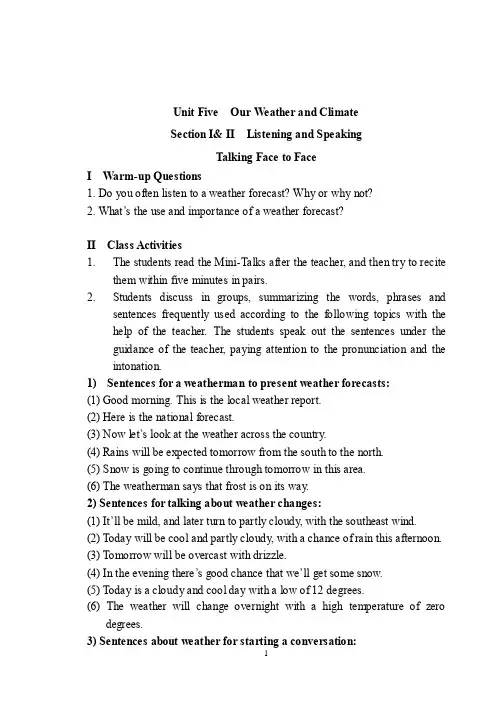
Unit Five Our W eather and ClimateSection I& II Listening and SpeakingTalking Face to FaceI W arm-up Questions1. Do you often listen to a weather forecast? Why or why not?2. What’s the use and importance of a weather forecast?II Class Activities1.The students read the Mini-Talks after the teacher, and then try to recitethem within five minutes in pairs.2.Students discuss in groups, summarizing the words, phrases andsentences frequently used according to the following topics with the help of the teacher. The students speak out the sentences under the guidance of the teacher, paying attention to the pronunciation and the intonation.1)Sentences for a weatherman to present weather forecasts:(1) Good morning. This is the local weather report.(2) Here is the national forecast.(3) Now let’s look at the weather across the country.(4) Rains will be expected tomorrow from the south to the north.(5) Snow is going to continue through tomorrow in this area.(6) The weatherman says that frost is on its way.2) Sentences for talking about weather changes:(1) It’ll be mild, and later turn to partly cloudy, with the southeast wind.(2) Today will be cool and partly cloudy, with a chance of rain this afternoon.(3) Tomorrow will be overcast with drizzle.(4) In the evening there’s good chance that we’ll get some snow.(5) Today is a cloudy and cool day with a low of 12 degrees.(6) The weather will change overnight with a high temperature of zerodegrees.3) Sentences about weather for starting a conversation:(1) What’s the weather like today?(2) What is the weather report?(3) What’s the temperature?(4) What’s it like outside?(5) Will it be a nice day?(6) Lovely day, isn’t it?(7) What do you think of the weather here?3. Act-Out Activities1) Students read the sample dialogues after the teacher, trying to imitate theteacher\s pronunciation and intonation.2) Ask the students to read the sample dialogues in pairs. Then categorize theexpressions for asking questions about the weather and describing the weather conditions.4. Do Exercises 5 and 6 in pairs.Being all earsⅢ. Learning Sentences for W orkplace Communication1.Warm–up:Give the students a few minutes to read through the printed materials for each listening item in Listen and Repeat, Listen and Match. While listening, students should try to remember the meaning of each of the sentences and pay more attention to the key words.fairly 相当地mild 温和的,暖和的2. Key to Listen and Match:1-f, 2-h, 3-i 4-j, 5-g, 6-c, 7-e, 8-d, 9-a, 10-bListen and RespondKey: 1-D 2-C 3-B 4-D 5-A 6-D3. Handling a Dialogue:Script:Li Hong: Hi, Pat! Why didn’t you go to the party last night?Pat: Because it was so cold and rainy.Li Hong: That’s too bad! It was a really good party. Hey, why don’t we go out for a walk this afternoon, Pat? I need some exercise.Pat: Go out for a walk? But its so cold out.Li Hong: Cold out? Wh at’s the temperature?Pat: About 13℃.Li Hong: 13℃? That’s not cold. Just wait until winter.Pat: Why?Li Hong: Well …it snows a lot and sometimes it’s very cold. Last winter it was 7 degree below zero for three weeks. And it was windy, too.Pat: That sounds awful!Li Hong: It wasn’t all that bad. The sun was out almost every day.4. Understanding a short Speech / TalkKey: 1. tourist cities 2. beautiful3. too cold in winter4. plenty of sunshine5. the sea6. thousands of7. from both home and abroad8. at the best time of yearUnit Five Our W eather and ClimateSection III Trying your handI. Sample Analysis1. The teacher summarize briefly the format and language used in weatherforecasts.2. A weather report or forecast is a very useful aid in our daily life. Knowingthe usual format for giving a weather forecast helps us a lot in understanding a weather forecast in English. Figures, measurement units, graphics, weather terms, and broken short passages are often used to forecast weather conditions. In general, the language used to forecast weather should be concise, clear, familiar and vivid.II. Simulated Writing1. The students read and translate the two sample weather forecasts intoChinese.Useful words and expressions for describing weather:1) to rain all day 全天有雨2) to be sunny / fine / cloudy / rainy / hot / cool天气将会是阳光充足、晴、多云、有雨、很热、凉爽3) to be going to warm up / clear up 天气要转暖/放晴4) quite a warm day with temperature around 24℃天气很暖和,气温在24度左右。


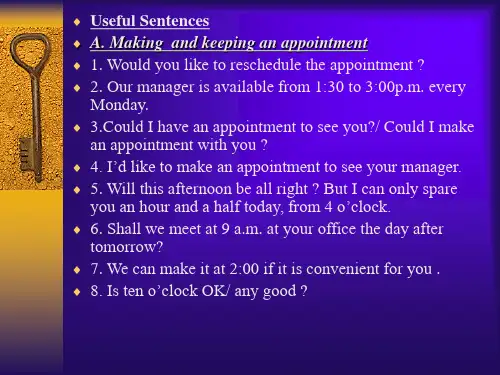


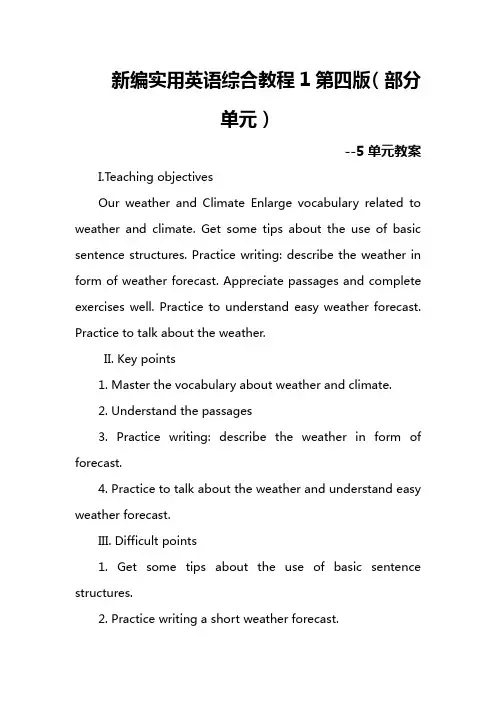
新编实用英语综合教程1第四版(部分单元)--5单元教案I.Teaching objectivesOur weather and Climate Enlarge vocabulary related to weather and climate. Get some tips about the use of basic sentence structures. Practice writing: describe the weather in form of weather forecast. Appreciate passages and complete exercises well. Practice to understand easy weather forecast. Practice to talk about the weather.II. Key points1. Master the vocabulary about weather and climate.2. Understand the passages3. Practice writing: describe the weather in form of forecast.4. Practice to talk about the weather and understand easy weather forecast.III. Difficult points1. Get some tips about the use of basic sentence structures.2. Practice writing a short weather forecast.3. Appreciate passages and complete exercises well.IV. Teaching methodology1. Task-based language teaching2. Direct method V. Teaching procedures Section I Talking Face to Face Imitating Mini-Talks 1. Work in pairs. Practice the following mini-talks about greeting and introducing people. Acting out the T asks 2. Work in pairs and act out the tasks by following the above mini-talks.Key for reference:1.Task: Ask for Mark’s comments on the weather.2.T ask: Ask about and describe the weather at this time of year.3.3. T ask: Ask Mr. Green about the weather condition tomorrow and plan an activity.4.4. Task: Talk about the change of the weather from long rainy days.5.5. Task: Complain about a cold day. Studying Weather Forecasts6.A weather forecast id a statement that tells the public what the weather condition is going to be. We need to watch weather forecasts on TV or hear them over the radio every day.It is part of our life.Read the following samples of weatherforecasts carefully and try to use the information to practice short dialogues. Following Sample Dialogues7.Read the following sample dialogues and try to perform your own tasks. Putting Language to Use8.Mr. Parks is talking about the weather of two places in the United States with her students.Read aloud the following dialogue with your partner by putting in the missing words.9.There is going to be s sports meet tomorrow.Bob is worried about the weather and you are talking about it. Fill in the blanks according to the clues given in the brackets. Then act it out with your partner.1. Listen to 10 sentences for workplace communication cross-referenced with their Chinese translations.Script: (e.g) 1. It look likes rain. 2. Is it going to be fine this week。
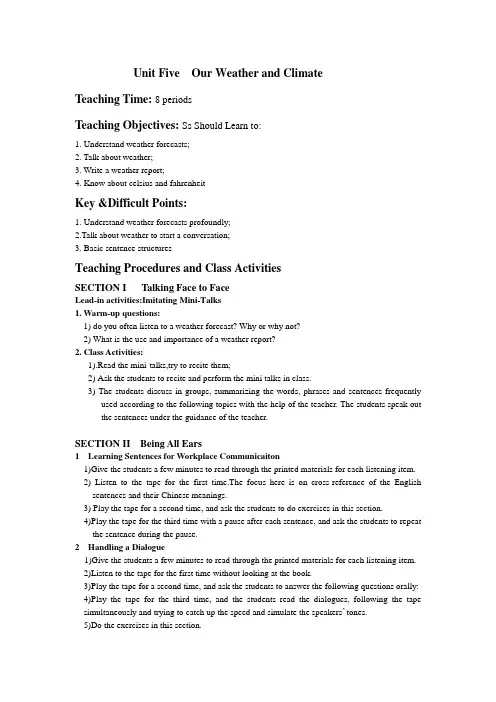
Unit Five Our Weather and ClimateTeaching Time: 8 periodsTeaching Objectives: Ss Should Learn to:1. Understand weather forecasts;2. Talk about weather;3. Write a weather report;4. Know about celsius and fahrenheitKey &Difficult Points:1. Understand weather forecasts profoundly;2.Talk about weather to start a conversation;3. Basic sentence structuresTeaching Procedures and Class ActivitiesSECTION I Talking Face to FaceLead-in activities:Imitating Mini-Talks1. Warm-up questions:1) do you often listen to a weather forecast? Why or why not?2) What is the use and importance of a weather report?2. Class Activities:1).Read the mini-talks,try to recite them;2) Ask the students to recite and perform the mini talks in class.3) The students discuss in groups, summarizing the words, phrases and sentences frequentlyused according to the following topics with the help of the teacher. The students speak out the sentences under the guidance of the teacher.SECTION II Being All Ears1 Learning Sentences for Workplace Communicaiton1)Give the students a few minutes to read through the printed materials for each listening item.2) Listen to the tape for the first time.The focus here is on cross-reference of the Englishsentences and their Chinese meanings.3) Play the tape for a second time, and ask the students to do exercises in this section.4)Play the tape for the third time with a pause after each sentence, and ask the students to repeatthe sentence during the pause.2 Handling a Dialogue1)Give the students a few minutes to read through the printed materials for each listening item.2)Listen to the tape for the first time without looking at the book.3)Play the tape for a second time, and ask the students to answer the following questions orally:4)Play the tape for the third time, and the students read the dialogues, following the tape simultaneously and trying to catch up the speed and simulate the speakers’ tones.5)Do the exercises in this section.3 Understanding a Short Speech/Talk1)Give the students a few minutes to read through the printed materials for each listening item.2)Listen to the tape for the first time without looking at the book.3) Play the tape for a second time, and ask the students to do the exercises in this section.4)Play the tape for the third time with a pause after each sentence, and ask the students to takenotes of the key words.SECTION III Trying Your HandPracticing Applied Writing1 Sample analysis: T eacher summarizes briefly the format and language used in weather forecasts. The teacher may show the following passage with PPT (If there is no PPT prepared, ask the students to take a dictation of the passage). Afterwards, ask the students to read it and translate it into Chinese orally.2Simulated writing:1)The students read and translate the sample weather forecasts with the help of the teacher.2)Do Exercises 2, 3 and 4 in groups.SECTION IV Maintaining a Sharp EyePassage 1 We can Make a Difference1 Warm-up questions: What is the consequences of global warming?2 Guided reading aloud of the passage:The students read the passage individually. The teacher should pay attention to correcting the students’ pronunciation and intonation.3 Explanation of difficult words and expressions:The students have a discussion in groups to pick out the difficult words and expressions in the whole passage which they don’t understand and report them to the class. The teacher will demonstrate the usage of those chosen points, and then ask the students to make up at least two sentences with them in groups.Key Language Points in Teacher’s Book1) trap:store---so that it cannot escape. Eg: A filter can trap dust from the air.2)stand-by:readiness for duty.Eg: The soldiers are on stand-by, ready to set out at any time.3)stuff:things. Eg: There is a lot of stuff about in today’s newspaper.4)membership:being a member of an organization. eg:He lost his membership card and was denied access.5)swell:grow bigger. Eg: The population swelled during that time.4 Understanding the passage in detail:1)Paragraph 1:Group work: Give the students 3 minutes to prepare the translation of the firstparagraph, and then an oral class presentation is required.2)Paragraph 2: Ask one or two students to read this paragraph.3)Paragraph 3: 1) Pair work: One student reads this paragraph loudly, and another helps correcthis or her pronunciation. And then they change their roles to do the same work again. 2) Work together to summarize the general idea of Para. 3, and then present it in class.5 Summary of the passage Group work: The students have a discussion of the main idea of the passage. The students’ ideas may vary, and the teacher gives his or her own idea.6 Assignments for this section: 1. Recite Paragraphs 2 and 3 2. Preview Passage II.PASSAGE II The British Like Talking About the Weather1 Warm-up activities: How do the British generally start their coversations?2 Guided reading aloud of the passage:The students read the passage and get its general idea.3 Explanation of difficult words and expressions:Choose language points in Language Points in Teacher’s Book4 Understanding the passage in detail:Paragraph 1: 1) The students read this paragraph together.2) Dictation practice: The teacher reads each sentence of the paragraph for or three times accordingto the students’ English level, and the students write them down. Afterwards, the students check up them with their partners.Paragraph 2:1) Ask two or three students to read the paragraph individually.2) Pair work: One student asks about 2 or 3 specific questions about Paragraphs 2, and the otherone gives the answers. Then the students exchange their roles to do the same work again. The rest of the passage: 1) The students read this part following the teacher.2) Group work: The teacher draws the following table on the blackboard (or shows it withPPT), and then asks the students to have a group discussion for matching the greeting sentences in Column A with the countries they are spoken in Column B. In the end, the whole class try to pronounce the greeting words in different languages.5Summary of the passage:1)Group work: The students have a discussion to translate the passage into Chinese.2)Groups work: Each group tries to pick out at least 5 expressions or sentences from thepassage witch they think are worth remembering. Afterwards, ask some groups to write them down on the blackboard and ask the whole class to read them aloud.6 Assignments for this section:Read the passage again.。
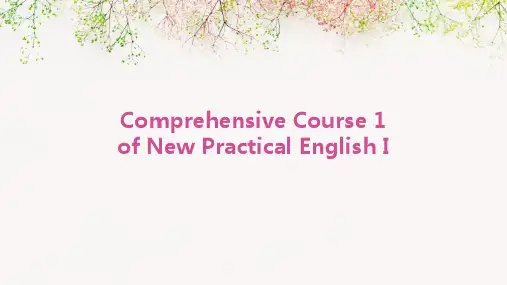


Unit Five Our Weather and ClimateTeaching Time: 8 periodsTeaching Objectives: Ss Should Learn to:1.Understand weather forecasts;2.Talk about weather;3.Write a weather report;4.Know about celsius and fahrenheitKey &Difficult Points:1. Understand weather forecasts profoundly;2.Talk about weather to start a conversation;3. Basic sentence structuresTeaching Procedures and Class ActivitiesSECTION I Talking Face to FaceLead-in activities:Imitating Mini-Talks1.Warm-up questions:1)do you often listen to a weather forecast? Why or why not?2)What is the use and importance of a weather report?2.Class Activities:1).Read the mini-talks,try to recite them;2)Ask the students to recite and perform the mini talks in class.3)The students discuss in groups, summarizing the words, phrases and sentences frequentlyused according to the following topics with the help of the teacher. The students speak out the sentences under the guidance of the teacher.SECTION II Being All Ears1 Learning Sentences for Workplace Communicaiton1)Give the students a few minutes to read through the printed materials for each listening item.2)Listen to the tape for the first time.The focus here is on cross-reference of the Englishsentences and their Chinese meanings.3)Play the tape for a second time, and ask the students to do exercises in this section.4)Play the tape for the third time with a pause after each sentence, and ask the students to repeatthe sentence during the pause.2 Handling a Dialogue1)Give the students a few minutes to read through the printed materials for each listening item.2)Listen to the tape for the first time without looking at the book.3)Play the tape for a second time, and ask the students to answer the following questions orally:4)Play the tape for the third time, and the students read the dialogues, following the tape simultaneously and trying to catch up the speed and simulate the speakers ’tones.5)Do the exercises in this section.3 Understanding a Short Speech/Talk1)Give the students a few minutes to read through the printed materials for each listening item.2)Listen to the tape for the first time without looking at the book.3) Play the tape for a second time, and ask the students to do the exercises in this section.4)Play the tape for the third time with a pause after each sentence, and ask the students to takenotes of the key words.SECTION III Trying Your HandPracticing Applied Writing1 Sample analysis: Teacher summarizes briefly the format and language used in weather forecasts. The teacher may show the following passage with PPT (If there is no PPT prepared, ask the students to take a dictation of the passage). Afterwards, ask the students to read it and translate it into Chinese orally.2 Simulated writing:1)The students read and translate the sample weather forecasts with the help of the teacher.2)Do Exercises 2, 3 and 4 in groups.SECTION IV Maintaining a Sharp EyePassage 1 We can Make a Difference1Warm-up questions: What is the consequences of global warming?2Guided reading aloud of the passage: The students read the passage individually. The teacher should pay attention to correcting the students ’pronunciation and intonation.3 Explanation of difficult words and expressions:The students have a discussion in groups to pick out the difficult words and expressions in the whole passage which they don ’tunderstand and report them to the class. The teacher will demonstrate the usage of those chosen points, and then ask the students to make up at least two sentences with them in groups. Key Language Points in Teacher ’ s Book1) trap:store---so that it cannot escape. Eg: A filter can trap dust from the air.2)stand-by:readiness for duty.Eg: The soldiers are on stand-by, ready to set out at any time.3)stuff:things. Eg: There is a lot of stuff about in today’s newspaper.4)membership:being a member of an organization. eg:He lost his membership card andwas denied access.5)swell:grow bigger. Eg: The population swelled during that time.4Understanding the passage in detail:1)Paragraph 1: Group work: Give the students 3 minutes to prepare the translation of the firstparagraph, and then an oral class presentation is required.2)Paragraph 2: Ask one or two students to read this paragraph.3)Paragraph 3: 1) Pair work: One student reads this paragraph loudly, and another helps correcthis or her pronunciation. And then they change their roles to do the same work again. 2) Work together to summarize the general idea of Para. 3, and then present it in class.5Summary of the passage Group work: The students have a discussion of the main idea of the passage. The students’ideas may vary, and the teacher gives his or her own idea.6Assignments for this section: 1. Recite Paragraphs 2 and 3 2. Preview Passage II.PASSAGE II The British Like Talking About the Weather1 Warm-up activities:How do the British generally start their coversations?2 Guided reading aloud of the passage:The students read the passage and get its general idea.3 Explanation of difficult words and expressions:Choose language points in Language Points in Teacher ’ s Book 4Understanding the passage in detail:Paragraph 1: 1) The students read this paragraph together.2) Dictation practice: The teacher reads each sentence of the paragraph for or three times accordingto the students ’English level, and the students write them down. Afterwards, the students check up them with their partners.Paragraph 2: 1) Ask two or three students to read the paragraph individually.2)Pair work: One student asks about 2 or 3 specific questions about Paragraphs 2, and the otherone gives the answers. Then the students exchange their roles to do the same work again.The rest of the passage: 1) The students read this part following the teacher.2)Group work: The teacher draws the following table on the blackboard (or shows it with PPT),and then asks the students to have a group discussion for matching the greeting sentences in Column A with the countries they are spoken in Column B. In the end, the whole class try to pronounce the greeting words in different languages.5 Summary of the passage:1)Group work: The students have a discussion to translate the passage into Chinese.2)Groups work: Each group tries to pick out at least 5 expressions or sentences from thepassage witch they think are worth remembering. Afterwards, ask some groups to write them down on the blackboard and ask the whole class to read them aloud.6Assignments for this section:Read the passage again.。